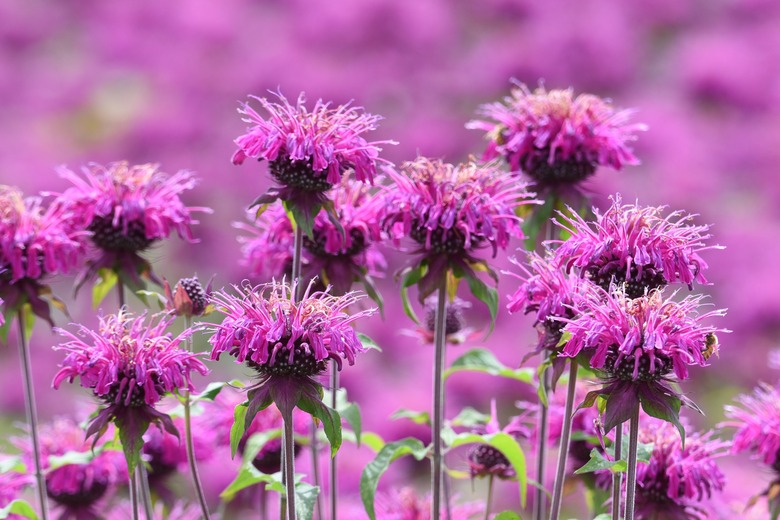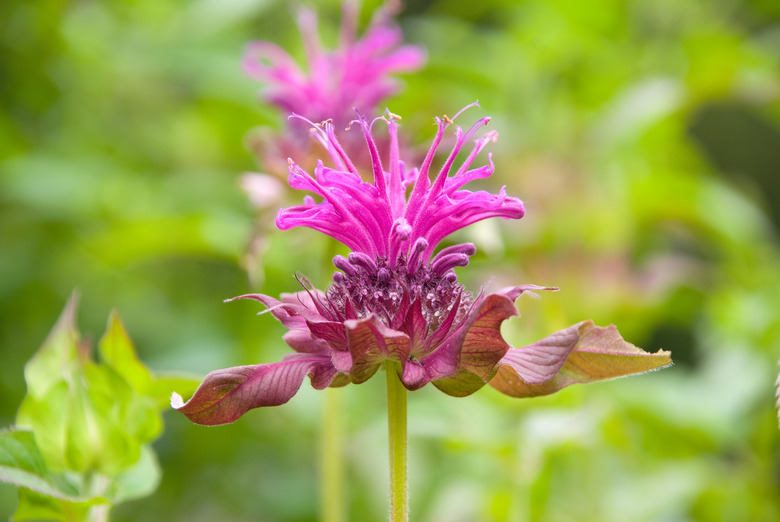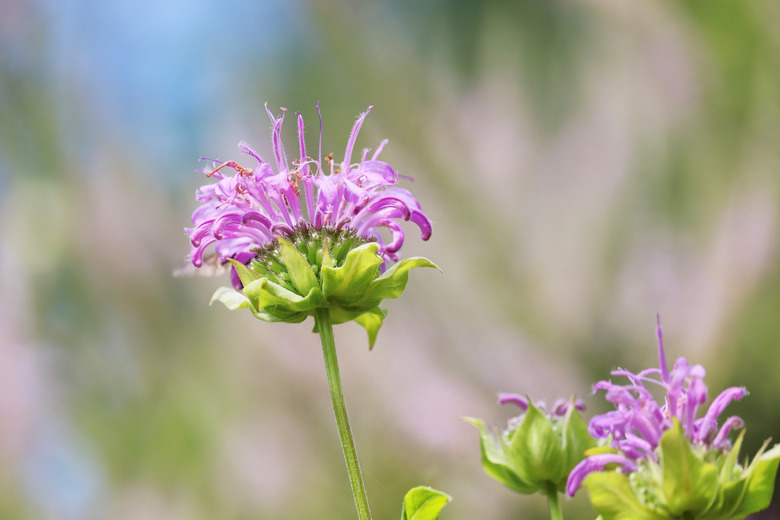How To Grow Bee Balm
- Best uses for bee balm
- How to grow bee balm
- In what zone does bee balm grow best?
- When should you plant bee balm?
- Soil, sunlight and water recommendations for bee balm
- How to propagate bee balm
- How to winterize bee balm
- How to harvest bee balm
- Common pests and other problems for bee balm
- Common diseases for bee balm
Bee balm (Monarda spp.) is an herbaceous perennial in the mint family, and it is also known as horsemint. This perennial plant boasts unusual-looking, pretty flowers and grows to a medium height, making it a great addition in many areas of the yard, including gardens. It comes in a variety of different colors, such as red, pink, white and purple, and these blooms are very attractive to a wide range of pollinators. Bee balm is also sometimes referred to as wild bergamot, although it isn't the same as the plant that produces the bergamot for tea.
Overall, bee balm is a low-maintenance plant that doesn't require a lot of specialized care. Once planted, it will do well and will continue to spread and thrive if sun is abundant. Bee balm isn't prone to many pests or diseases, making it a hardy choice for beginning gardeners or those who don't want to spend a lot of time and energy tending to planting beds. Some of the popular species include Monarda didyma (USDA zones 4-9), which is a bright red, and Monarda fistulosa (zones 3-9), which has colors that range from pink to lavender. Both of these are native plants.
Best Uses for Bee Balm
The bee balm plant can be used in a variety of different capacities. Homeowners and gardeners alike love this plant for decoration, as the blooms are beautiful and the flowers, foliage, and stems smell lovely. The plant tends to be on the taller side, so it pairs well with many lower-growing flowers or plants and gives some height and interest to a planting bed. Depending on the species and cultivar, it can grow between 2 and 4 feet tall, but there are also dwarf selections that are around 10 inches in height. Another common use for bee balm is as a border plant, sometimes mixed with phlox, black-eyed Susans or other colorful plantings.
The flowers on bee balm are unusual-looking and attractive. They bloom in summer, and if deadheaded regularly, they will continue to flower. A popular addition to pollinator gardens, bee balm attracts everything from hummingbirds to butterflies to bees. Since the plants come back every year and are easy to grow, they make a nice addition to any garden area that needs a little color and interest as long as there is plenty of sunshine. Bee balm can be grown in pots as well, and it is also a popular addition in herb gardens. The plant blends in well with other flowering herbs, such as coneflowers, sage and lavender.
Bee balm gets its name from the fact that it attracts bees in droves and has been used medicinally for treating bee stings, but it has also been used to address other maladies over time. For example, the Native Americans used this herb to deal with a variety of different health issues, and they made Oswego tea and other concoctions from the plant.
How to Grow Bee Balm
- Common Name: Bee balm
- Botanical Name: Monarda spp.
- When to Plant: Spring or fall
- USDA Zones: 3-9
- Sun Exposure: Full sun
- Soil Type: Well-draining soil
- When it's in Trouble: White on leaves can signify powdery mildew
- When it's Thriving: Green leaves and an abundance of colorful flowers
Starting Bee Balm From Seed
Sow seeds outdoors at a depth of 1/8 inch in the spring after any danger of frost has passed. Bee balm can be sown in the fall as well; just keep in mind that the plant matures somewhere around the 110- to 120-day mark, so there will be a wait for flowers until the following season.
Also, be sure to plant well before the first frost in autumn so that they have the chance to get established before winter weather settles in. Either way, water thoroughly once seeds are in the ground and check the package to see how many days it will take for them to germinate, as it can differ. Space plants 18 to 24 inches apart so they have plenty of room to grow and good air circulation.
In What Zone Does Bee Balm Grow Best?
Bee balm grows well in USDA plant hardiness zones 3 through 9. Be sure to check on the particular species being planted, however, as certain ones may be slightly different in terms of hardiness. For example, the USDA recommends growing scarlet bee balm in zones 4 through 9.
When Should You Plant Bee Balm?
Bee balm can be planted in the spring or in the fall. The key is to make sure this plant doesn't experience any frost in its growth cycle in the spring or before it is established in the fall. For those in climates where the weather can be variable, start seeds indoors eight to 10 weeks prior to the final spring frost date to be on the safe side for spring plantings. If fall frost is a concern, try planting in late summer instead of fall.
Soil, Sunlight and Water Recommendations for Bee Balm
For best results, plant bee balm in a location that offers full sun. The plant can survive in partial shade, but it won't grow as well, and the lack of sunshine will reduce blooms as well as make it look a bit scraggly. Watering can be a little tricky, as this plant grows best on moist soil, but too much water can cause mildew issues. Watering at the base of the plant is advisable. Make sure not to overwater. This is especially true in areas where humidity is high.
When selecting a location for this plant, be sure to consider the fact that it attracts bees. It might be best to steer clear of patios, deck areas and places where children play when choosing a spot for bee balm. The flowers are showy enough to appreciate from a little bit of distance, which should cut down on the risk of being stung.
This plant is rather forgiving when it comes to soil, but if it is planted in a clay type, it needs to be able to drain well. Bee balm doesn't like to sit in water, and it can experience root rot if the location is too wet. Even though it will grow in most soils, amending with a little compost can be helpful because the healthier the plant, the less likely it will be to develop disease. Keep in mind that a properly fertilized bee balm plant will grow larger and be more vibrant than one left to survive in regular soil. Start the growing season with some nitrogen-based fertilizer to support the regeneration of the plant, and it will reward you.
How to Propagate Bee Balm
Since bee balm is a member of the mint family, it behaves much like that plant in terms of growth and spread. It self-propagates and will easily spread over time to take a clumping form because of its rhizomes. This is wonderful if the goal is to have a lot of bee balm. Homeowners who don't want a lot of this plant might consider potting it instead to keep things under better control. Part of the plant should be dug out and divided every few years to keep it from getting too overcrowded. This means it can be planted elsewhere in the garden or the front yard. It can also be shared with neighbors if there is already plenty in the landscape.
How to Winterize Bee Balm
Bee balm is a perennial, so it comes back every year when planted in its hardiness range. To ensure it overwinters well, cut the plant back to just a few inches after the first frost or before winter settles in. If winters are particularly cold, feel free to mulch a little bit to help protect the plant until spring.
How to Harvest Bee Balm
Bee balm does not have to be harvested. It can just be enjoyed for the beauty of the flowers and/or used to encourage pollinators to visit. That said, it can be dried for use in potpourri or even used fresh in salads. To harvest and dry, snip stalks with flowers at the base in the late morning hours. Tie the stems together with some string at the bottom and hang upside-down to dry. To harvest for fresh use, simply pinch the leaves and flowers to gather enough for a cup of tea or to use as a garnish.
Common Pests and Other Problems for Bee Balm
Bee balm can wind up with some mites, aphids and certain types of borers. Keep an eye out for pests and treat if needed. Use an insecticidal soap if needed to eliminate them. Prevention includes mulching to cut down on the weeds that attract many of these pests in the first place. Overall, bee balm doesn't tend to suffer too badly from garden insects compared to many other plants.
Common Diseases for Bee Balm
Powdery mildew is a pretty common problem for bee balm plants, but there are steps that can be taken to help prevent it from getting a foothold. Make sure to abide by the recommended spacing when planting and divide every few years to make some space between the plants. If possible, it can also help to locate the plants where they will get some good morning sun to dry the dew off the leaves.
Use care with watering if the humidity is high, as that can contribute to the problem and encourage mildew growth. Try not to splash leaves, especially during high humidity periods, as that provides a good environment for the powdery mildew. Keep an eye out for the telltale powdery white on the leaves of the bee balm.
Planning ahead can also make sense; some bee balm cultivars are more resistant to mildew than others. Seek these out at a nursery or online and plant these for a little extra insurance. Ask for Marshall's Delight, Petite Wonder, Jacob Cline or other cultivars that have been bred for being resistant to this disease.


